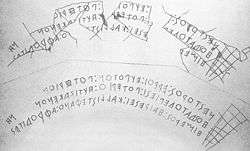Nestor's Cup (Pithekoussai)
Nestor's cup is an eighth century BC wine cup discovered in 1954 in Lacco Ameno, the ancient Pithekoussai, an island in the Gulf of Naples (Italy). The cup has a three-line inscription, one of the earliest surviving examples of writing in the Greek alphabet.

Cup
The cup is a skyphos or kotyle[lower-alpha 1] made in Rhodes in the eighth century BC,[1] and decorated in the geometric style.[2] It was found in 1954[3] in a cremation grave on the island of Ischia, home of the ancient Pithekoussai,[1] dating to a little before 700 BC.[4]
The grave was for a child aged around 10 to 14.[4] Along with Nestor's cup, it also contained fragments of 25 other vases,[lower-alpha 2][6] as well as a silver fibula.[7] The body was cremated on a pyre separate from the grave, and the grave goods were ritually broken and burnt on the same pyre.[4]
Inscription

Νεστορος : ε[ιμ?]ι[lower-alpha 3] : ευποτ[ον] : ποτεριον : |
I am the cup of Nestor good for drinking. |
| —Jeffery 1963, p. 235 | —Faraone 1996, p. 78 |
A three-line inscription, scratched onto the side of the cup [9] is one of the earliest extant Greek inscriptions.[1] The inscription was added to the cup after its manufacture,[8] and dates to the late eighth century.[1] The inscription is in a Euboean form of the alphabet,[9] in small, neat letters.[10] All three lines are written from right to left[8] – according to Meiggs and Lewis, "virtually unique in a Greek text".[11] The symbol ":" is used as punctuation.[10]
The second and third lines are in dactylic hexameter.[12] The form of the first line is less certain: it has been read as prose, iambic trimeter, catalectic trochaic trimeter, or a lyric meter.[13]
The interpretation of the inscription depends on a lacuna in the first line: depending on how it is restored, the inscription may be contrasting the cup from Pithekoussai with the legendary cup of Nestor described in the Iliad (Iliad 11.632 ff.), or identifying the cup as one owned by Nestor.[14] The original publication of the inscription accepted the first possibility;[15] by 1976, P.A. Hansen wrote that "no less than fifteen" possible restorations of the first lacuna had been published. By the 1990s, it was generally thought that the cup is in fact claiming to be Nestor's.[16] The restoration proposed by Yves Gerhard in 2011 once again argues that the inscription is contrasting the Pithekoussan cup with that of Nestor.[17]
Notes
- skyphos: Watkins 1976, Hansen 1988, West 1994, Gaunt 2017. kotyle: Johnston & Andriomenou 1989, Faraone 1996, Pavese 1996
- Four kraters, four other drinking cups, three oinochoai, a jar, and seventeen aryballoi and lekythoi.[5]
- The restoration of the second word of the inscription is the main point of contention in the reading of the Nestor's cup inscription.[9] Jasper Gaunt considers ειμι the most probable restoration, with Lilian Jeffery, Martin Litchfield West and Peter Allan Hansen among the proponents of the reading.[4]
References
- Faraone 1996, p. 77.
- Page 1956, p. 95.
- Watkins 1976, p. 25.
- Gaunt 2017, p. 96.
- Gaunt 2017, pp. 94–95.
- Hansen 1976, p. 27.
- Gaunt 2017, p. 94.
- Page 1956, p. 96.
- Gerhard 2011, p. 7.
- Jeffery 1963, p. 236.
- Meiggs & Lewis 1969, p. 1.
- Watkins 1976, p. 33.
- Hansen 1976, p. 33.
- Watkins 1976, p. 37.
- Watkins 1976, p. 39.
- West 1994, p. 9.
- Gerhard 2011, pp. 7–9.
Works cited
- Faraone, Christopher A. (1996). "Taking the "Nestor's Cup Inscription" Seriously: Erotic Magic and Conditional Curses in the Earliest Inscribed Hexameters". Classical Antiquity. 15 (1).
- Gaunt, Jasper (2017). "Nestor's Cup and its Reception". In Slater, Niall W. (ed.). Voice and Voices in Antiquity.
- Gerhard, Yves (2011). "La "Coupe de Nestor": Reconstitution du Vers 1". ZPE. 176.
- Hansen, P. A. (1976). "Pithecusan Humour: The Interpretation of "Nestor's Cup" Reconsidered". Glotta. 54 (1).
- Jeffery, L.H. (1963). The Local Scripts of Archaic Greece: A Study of the Origin of the Greek Alphabet and its Development from the Eighth to the Fifth Centuries B.C. Oxford: Oxford University Press.
- Page, Denys (1956). "Greek Verses from the Eighth Century BC". The Classical Review. 6 (2).
- Pavese, C. O. (1996). "La inscrizione sulla kotyle di Nestor da Pithekoussai". ZPE. 114.
- Watkins, Calvert (1976). "Observations on the Nestor's Cup Inscription". Harvard Studies in Classical Philology.
- West, Stephanie (1994). "Nestor's Bewitching Cup". ZPE.